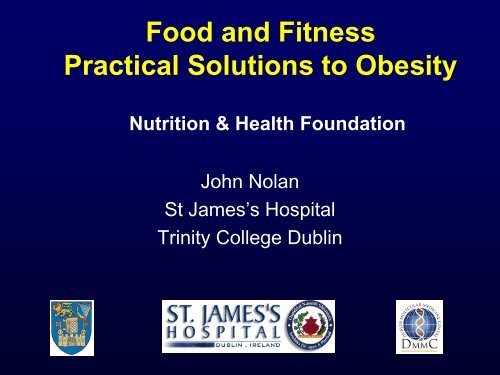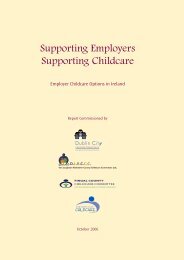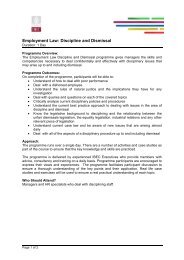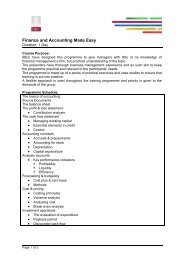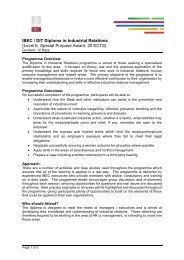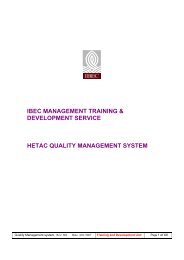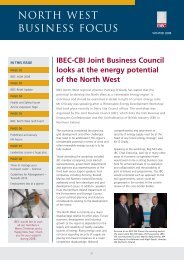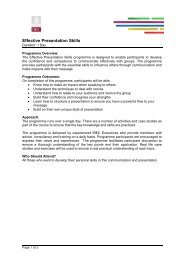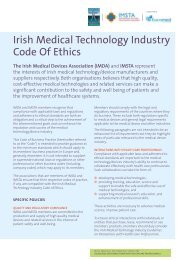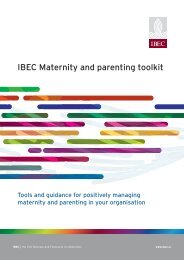Nolan NHF for web.pdf - Nutrition and Health Foundation
Nolan NHF for web.pdf - Nutrition and Health Foundation
Nolan NHF for web.pdf - Nutrition and Health Foundation
Create successful ePaper yourself
Turn your PDF publications into a flip-book with our unique Google optimized e-Paper software.
Food <strong>and</strong> Fitness<br />
Practical Solutions to Obesity<br />
<strong>Nutrition</strong> & <strong>Health</strong> <strong>Foundation</strong><br />
John <strong>Nolan</strong><br />
St James’s Hospital<br />
Trinity College Dublin
Obesity: <strong>Health</strong> Complications<br />
• Type 2 diabetes<br />
• Hypertension<br />
• Cardiovascular diseases<br />
• PCOS<br />
• Cancer<br />
• Fatty liver disease (NASH)<br />
• Psychological illness<br />
• Social - discrimination
Obesity: Common Assumptions<br />
• It is simply a matter of behaviour<br />
• It is just a balance sheet: calories in vs<br />
calories out<br />
• It is not a medical issue<br />
Blame game
Blaming Food & the Food<br />
Industry<br />
• Problems arise from:<br />
– Portion sizes<br />
– How we shop<br />
– How we cook<br />
– Where <strong>and</strong> when we eat<br />
Irish food is good!
<strong>Health</strong>y diet <strong>and</strong> exercise
Cali<strong>for</strong>nia cattle lifestyle
Exercise – diet – low stress - lean
Sedentary – stress - fat
‘Starter’ portion<br />
Starter course:<br />
20 x 10 cm<br />
platter<br />
~40 chicken<br />
wings
32 ounce gulp
Bagel<br />
20 Years Ago Today<br />
Cheeseburger<br />
20 Years Ago<br />
Today<br />
140 calories<br />
350 calories 333 calories 590 calories<br />
Chips<br />
20 Years Ago Today<br />
210 calories 610 calories
<strong>Nutrition</strong> Support<br />
• Lack of access to good nutritional advice<br />
• Fad diets<br />
• Short-termism<br />
• Denial<br />
“Some people like food, however,<br />
Other people like to eat”
Hypothalamic control of appetite<br />
_<br />
MCH<br />
Orexins<br />
Other<br />
Hypothalamic<br />
Nuclei<br />
+ _<br />
Lateral<br />
Hypothalamus<br />
+<br />
POMC<br />
ARCUATE<br />
+ _<br />
LEPTIN<br />
NPY<br />
AGRP<br />
EAT!!!!
Blaming Inactivity<br />
• We have a favourable climate<br />
• Uncrowded countryside<br />
BUT<br />
• We lack access to good advice on physical<br />
activity
Obesity: What we have learnt<br />
• The problem is global<br />
• Threat to population health in 21 st century<br />
• The economic cost is huge<br />
• Complex interplay between central drive to<br />
eat <strong>and</strong> peripheral metabolism<br />
• Genetic contributors<br />
• Importance of early life
Early life effects on obesity<br />
In utero milieu<br />
Maternal factors<br />
Obesity, GDM<br />
Imprinting<br />
Epigenetic events<br />
Early infancy
50<br />
40<br />
Obesity Is A Risk Factor <strong>for</strong><br />
Type 2 Diabetes<br />
Age-adjusted relative risk of type 2 diabetes<br />
Men 1 42<br />
100 Women 2<br />
75<br />
93<br />
30<br />
20<br />
10<br />
0<br />
50<br />
40<br />
12<br />
25<br />
1.0<br />
2.2<br />
1.0<br />
8.1<br />
Early Onset Type 2 Diabetes Mellitus
SJH: Under 40’s compared to over 50’s with DM<br />
Younger<br />
T2DM n =<br />
149<br />
Older<br />
T2DM n = 217<br />
P<br />
Value<br />
Age (years) 35.2 (0.39) 61.6 (0.38)<br />
Male % 67.00 63.59<br />
Diastolic BP (mm/Hg) 80 (0.91) 78 (0.8) NS<br />
C peptide at diagnosis<br />
(µg/l)<br />
Total Cholesterol<br />
(mmol/l)<br />
3.27 (0.34) 3.48 (0.25) NS<br />
4.98 (0.12) 4.83 (0.07) NS<br />
LDL (mmol/l) 2.83 (0.07) 2.79 (0.06 NS<br />
Hatunic et al; Diabetes Vasc Dis Res 2005;2:73-75
Clinical <strong>and</strong> laboratory characteristics<br />
BMI (kg/m2)<br />
Younger<br />
T2DM n =149<br />
33.3 (1.65)<br />
Older<br />
T2DM n = 217<br />
30.7 (0.5)<br />
P Value<br />
Young Type 2 DM (
Exercise & Mitochondrial<br />
Function
Pre- <strong>and</strong> Post-Exercise Mean<br />
VO 2 max<br />
error bars represent SEM<br />
VO2 max (ml/min/kg) .<br />
4<br />
3.5<br />
3<br />
2.5<br />
2<br />
1.5<br />
1<br />
0.5<br />
***<br />
Control<br />
Young Type 2<br />
***P
Fasting Free Fatty Acids<br />
(FFA)<br />
Error bars represent SEM<br />
FFA (mmol/l) .<br />
1<br />
0.8<br />
0.6<br />
0.4<br />
0.2<br />
***<br />
Control<br />
Young Type 2<br />
***P
Obesity: exercise responses<br />
• Some individuals are less responsive to<br />
aerobic exercise<br />
• This may be due to genetic factors<br />
• More likely to be mainly due to<br />
environmental effects on metabolizing<br />
tissues
Insulin sensitivity<br />
control<br />
obese<br />
diabetic<br />
control<br />
obese<br />
diabetic<br />
< 30<br />
exercise<br />
Age (years)<br />
> 30<br />
exercise<br />
Figure 2. Exercise intervention in middle aged <strong>and</strong> older subjects has been shown to improve insulin sensitivity<br />
(right panel). However, we have shown that early onset obesity/insulin resistance is unresponsive to aerobic<br />
exercise (left panel). Our current research focuses on potential cellular <strong>and</strong> molecular causes <strong>for</strong> this discrepancy
Costs related to obesity: For<br />
discussion<br />
• If it is only a question of economic<br />
costs: should we not choose how to<br />
re-target the money already being<br />
spent on obesity complications?<br />
• Investment now in prevention <strong>and</strong><br />
treatment, <strong>for</strong> later (minimum of 5<br />
years later) savings?
COSTS OF DIABETES<br />
Irish Data<br />
Well care<br />
~€1,000/yr<br />
Illness care<br />
~€5,000/yr
The average excess costs of treating DM<br />
patients with <strong>and</strong> without complications<br />
(per person <strong>and</strong> year <strong>and</strong> by the type of diabetes)<br />
10000<br />
8000<br />
6000<br />
4000<br />
2000<br />
0<br />
516.6<br />
9998.2<br />
x 19<br />
Euros / person a year<br />
981.2<br />
7947.4<br />
x 8<br />
Excess costs of type 2 Excess costs of type 1<br />
n = 7 882 3 532 1 545 779<br />
Without complications With complications<br />
The average health care costs per person a year in the City<br />
of Helsinki: 1 254 euros/person © TK 2005
Finnish Study :<br />
A blueprint <strong>for</strong> treating IR<br />
• Weight reduction 5%<br />
• Fat intake 30 min per day (walking, jogging,<br />
swimming, aerobic ball games, skiing)
Development of diabetes during the lifestyle intervention<br />
in the intervention <strong>and</strong> control groups - DPS<br />
1.0<br />
0.9<br />
0.8<br />
0.7<br />
0.6<br />
0.5<br />
Intervention<br />
group<br />
Control group<br />
Risk reduction:<br />
58%<br />
0 1 2 3 4 5 6<br />
Year
DPS – How was it done?<br />
• 7 dietary counselling sessions during the<br />
first year <strong>and</strong> every 3 months thereafter<br />
• Individually tailored diet based on 3-day<br />
food diaries<br />
• Individually designed exercise programme
High risk<br />
approach<br />
Population<br />
approach<br />
Risk factor distribution<br />
Identify <strong>and</strong> treat those<br />
beyond a threshold <strong>for</strong><br />
risk factor<br />
• Resource intensive<br />
• Screening necessary<br />
• Provable in RCT<br />
• Large effect in small number of<br />
people<br />
Risk factor distribution<br />
Shift the whole population<br />
distribution of risk factor<br />
lower<br />
• Less resource intensive<br />
• Less amenable to RCT<br />
• No specific need to identify high risk<br />
subjects<br />
• Small effect in large number of people
THANK YOU FOR YOUR<br />
ATTENTION


